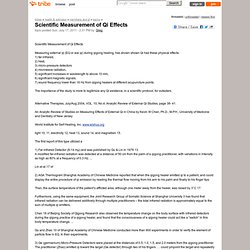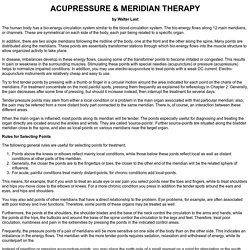

Chinese Medicine. Interview This next section was derived from a series of interviews with Amy, a practicing traditional Chinese doctor- and it is basically her speaking for herself either through translation or in more recent years in her very clear, often blunt English.

She has this unique way of making a very complicated subject clear and simple for her patients. She has subtle understanding of the body's inner workings that she combines with a simple easy- going wisdom. Amy always claims that she is "just a Chinese housewife" but she is truly an extraordinary person who has helped many people over the years to maximize their health and thereby maximize their potential also. So here she is talking about the basics. "Here is my simple analogy to help you understand the whole process better. Chinese Medicine. We will attempt to give both the Western and the Chinese answers to your questions where possible.

Amy always stressed "half-half," balance, so we will attempt to balance the Eastern and Western answers to your questions. 1) You say to steam the vegetables, why shouldn't I eat them raw? In Chinese terms the raw fruits and vegetables have the cold energy. In other words, it takes energy from your body in order to digest them and this reduces the amount of nutrition you can absorb from them. Eating raw fruits and vegetables introduces this cold energy into your body where it first effects your stomach and then can go in to become stuck at the site of an old injury or in a joint, leading to pain and stiffness in that area of the body.
In Western terms many of the vegetable's most essential antioxidant nutrients are locked inside their tough walled cells. 2) My husband has terrible back spasms and pain but he refuses to take any more pain medication or muscle relaxers. Martial Street Art: Interview with Roberto Sharpe 2.
Healing TUNING FORKS - MERIDIANS. Scientific Measurement of Qi Effects - Meridians and QI - tribe.net. Scientific Measurement of Qi Effects Measuring external qi (EQ or wai qi) during qigong healing, has shown shown Qi had these physical effects: 1) far-infrared, 2) heat, 3) micro-pressure detectors 4) microwave radiation, 5) significant increases in wavelength to above 10 mm, 6) significant magnetic signals, 7) sound frequency lower than 16 Hz from qigong healers at different acupuncture points.

The importance of the study is more to legitimize any Qi existance, in a scientific protocol, for outsiders. Alternative Therapies, July/Aug 2004, VOL. 10, No.4; Analytic Review of External Qi Studies, page 38- 41. An Analytic Review of Studies on Measuring Effects of External Qi in China by Kevin W Chen, Ph.D., M.P.H., University of Medicine and Dentistry of New Jersey World Institute for Self Healing, Inc. www.wishus.org light 10, 11, electricity 12, heat 13, sound 14, and magnetism 15. The first report of this type utilized a Lin et al.17 of. MERIDIAN THERAPY. By Walter Last The human body has a bio-energy-circulation system similar to the blood-circulation system.

The bio-energy flows along 12 main meridians, or channels. These are symmetrical on each side of the body, each pair being related to a specific organ. In addition, there are two single meridians following the midline of the body, one at the front and the other along the spine. Many points are distributed along the meridians. In disease, imbalances develop in these energy flows, causing some of the transformer points to become irritated or congested. Try to find tender points by pressing with a thumb or finger in a circular motion around the area indicated for each point on the charts of the meridians. Tender pressure points may stem from either a local condition or a problem in the main organ associated with that particular meridian; also, the pain may be referred from a more distant body part connected to the same meridian.
Rules for Selecting Points The liver is similar. Ba Duan Jing (8 Section Brocade)
Chi Cycle. Fu Chen Sung. Fu Chen Sung or Fu Qiankun (1872–1953) was a grandmaster of Wudangquan martial arts.

He was best known as one of the famed "Five Northern Tigers," and a third-generation master of Baguazhang who founded Fu Style Baguazhang. He was also a soldier and a supporter of Sun Yat-sen. Early life[edit] In 1900 he moved back to his home village to teach. He became well known in that part of China for defeating a large gang of bandits that attacked his village; he did so armed with a metal pole. After the Xinhai Revolution of 1911, Fu traveled to Fu Chou, Cheng Chou, as well as Shan Si Province, and beyond.
Military career[edit] In 1920 Fu joined the central army. In Beijing, Fu met Sun Lu-t'ang, Yang Chengfu, and many other skilled practitioners, with whom he exchanged knowledge. In late 1928 or 1929, at General Li Jinglin’s urging, the Central Gymnasium sent Fu south to teach at the Kuang Hsi and Guangzhou provincial school the Liang Kuang Kuo Shu Kuan (the Two Kuang's Martial Arts School.)